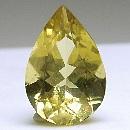|
|
||||||||||||||||
|
||||||||||||||||
|
||||||
|
|
|
|
Meionite
|
|
| | |
| Discovered in 1801; IMA status: Valid (pre-IMA; Grandfathered) | ||
|
| ||
|
Chemistry |
|
|
| |
|
Ca4Al6Si6O24(CO3) | |
|
|
Calcium Aluminum Silicate Carbonate |
|
Molecular Weight: |
934.71 gm |
|
Composition: |
Calcium |
17.15 % |
Ca |
24.00 % |
CaO |
|
|
Aluminum |
17.32 % |
Al |
32.73 % |
Al2O3 |
|
|
Silicon |
18.03 % |
Si |
38.57 % |
SiO2 |
|
|
Carbon |
1.28 % |
C |
4.71 % |
CO2 |
|
|
Oxygen |
46.22 % |
O |
|
|
|
|
|
100.00 % |
|
100.00 % |
= TOTAL OXIDE |
|
|
|
||||
|
Classification |
|
|
| |
|
SILICATES (Germanates) | |
|
8/J.13-20 | |
|
|
9 : SILICATES (Germanates)
|
|
Related to: |
Scapolite Group. Marialite-Meionite Series. Intermediate members are P42=n: |
|
Members of Group: |
Scapolite Group: Kembleite, Marialite, Meionite, Silvialite |
|
Varieties: |
Kembleite, Nuttallite |
|
Synonyms: |
ICSD 2628, Meyonite, PDF 44-1399, Wernerite |
|
|
|
|
Crystal Data |
|
|
|
|
|
Crystals prismatic, typically with flat pyramidal terminations, striated || [001], to 0.7 m; granular, massive. |
|
|
None |
|
|
|
|
|
Physical Properties |
|
|
|
|
|
Distinct on {100}{110} |
|
|
Irregular/Uneven, Conchoidal |
|
|
Brittle |
|
|
5.0 - 6.0 |
|
|
2.74 - 2.78 (g/cm3) |
|
|
Commonly orange to bright yellow to red under SW and LW UV light. |
|
|
Not Radioactive |
|
|
|
|
|
Optical Properties |
|
|
|
|
|
Colorless, white, grey; pink, violet, blue, yellow, orange-brown, brown; colorless in thin section. |
|
|
Transparent to opaque |
|
|
Vitreous to pearly or resinous. |
|
|
1.590 - 1.600 Uniaxial ( - ) |
|
|
0.034 - 0.038 |
|
|
n/a |
|
|
None |
|
|
|
|
|
Occurances |
|
|
|
|
|
Geological Setting: |
Typically in regionally metamorphosed rocks, especially marbles, calcareous gneisses, granulites, and greenschists. Also in skarns, some pegmatites, pneumatolytically or hydrothermally altered mafic igneous rocks, and ejected volcanic blocks. |
|
Common Associations: |
Plagioclase, Garnet, Pyroxenes, Amphiboles, Apatite, Titanite, Zircon |
|
Common Impurities: |
Mg, Na, K, Cl, H2O, S |
|
Type Locality: |
Monte Somma, Somma-Vesuvius Complex, Naples Province, Campania, Italy |
|
Year Discovered: |
1801 |
|
View mineral photos: | |
|
|
|
|
More Information |
|
|
|
|
|
| |
|
|
|
|
Meionite was named in 1801 by Rene Just Haüy from the Greek word for less, in reference to the less acute pyramidal form compared with Vesuvianite. Locations
for Meionite: most specimens are intermediate in the
series, see also marialite; some localities for highly
calcic material include: at Monte Somma and Vesuvius,
Campania, Italy. Around the Laacher See, Eifel district,
Germany. From Pargas and Pusunsaari, Finland. At Slyudyanka,
near Lake Baikal, Siberia, Russia. From Gooderham, Ontario,
and Grenville, Quebec, Canada. At Rossie, St. Lawrence
County, New York; Bolton, Worcester County, Massachusetts;
and Cutcane Creek, Fannin County, Georgia, USA. |
|
|
We
have not photographed our Meionite
gems. Please
check back soon. |
